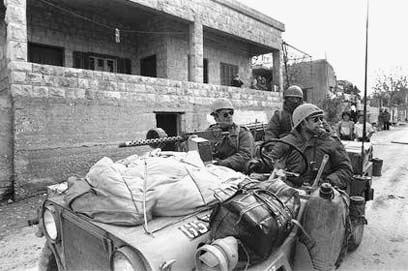Operation Litani
On March 11, 1978, three days before the start of Operation Litani (Hebrew: מבצע ליטני, 'Mivtsa Litani'), eleven terrorists from the Palestine Liberation Organization, led by Dalal al-Mughrabi, infiltrated Israel from Lebanon by sea, and took control of an Israeli civilian bus. The bus was traveling along a coastal road near Tel Aviv. 35 civilians, including 13 children, were killed, and 71 were wounded in the attack.
The attack, known as the "Coastal Road Massacre" (Hebrew: טבח כביש החוף, "Tevah Kvish HaHof"), demonstrated a clear desire to sabotage the peace process with Egypt. In response to this attack, the Israeli government decided to take military action against the PLO's terrorist infrastructures located in southern Lebanon, in order to push the PLO beyond the Litani River. In a few days, the IDF was able to reach the banks of the Litani River.

![]()
Operation Litani
Initiation of the operation
Three days after the Massacre of the Coastal Road, on the night of March 14th, 1978, the IDF decided to retaliate, and launched a vast operation in southern Lebanon, led by Infantry brigades from the 36th Division and the Headquarters of the Chief of Infantry and Paratroopers Corps. Later, these troops were joined by Armored Corps and smaller operational units. The announced objective of the operation was to destroy the bases of the PLO south of the Litani River in order to restore a sense of security in northern Israel.


Israeli soldiers crossing the Lebanese border to begin moving north
Israeli soldiers crossed the Lebanese border and began to move north. Israeli aircraft and ships secured the advance of the ground forces.
The plan for the operation, devised by Chief of Staff Motta Gur, and Commander of the Northern Region Command Avigdor "Yenosh" Ben Gal, included ground operations and the occupation of a territory extending for about 6 miles. It was estimated that this territory was supposed to house about 4,000 terrorists. In addition to the elimination of many terrorists, and the destruction of much of their infrastructure, the operation aimed at ensuring territorial continuity in South Lebanon in order to work together with the Army of South Lebanon, led by Major Saad Haddad.
On March 17, at the end of the first phase of the operation, it was decided to extend the area of the operation and advance to the banks of the Litani River. The original name of the operation was changed accordingly and became Operation Litani.
Many villages and towns that were used as headquarters by the terrorists were occupied during the operation, and the objectives on the ground were fully achieved. However, the terrorist infrastructure was not completely eradicated, and the city of Tire was not occupied, as the Chief of the General Staff feared that fighting in urban areas would cause too many casualties.
300 terrorists were eliminated during the fighting. The IDF lost 18 soldiers. On March 21st, Defense Minister Ezer Weizman ordered the IDF to end the operation. Following the operation, the UN Security Council decided to set up an international military force, UNIFIL, to maintain order in southern Lebanon. The coalition forces took control of the area in mid-June, just after the IDF's withdrawal.
Exchange of Prisoners


The armed forces advanced to the banks of the Litani River
On April 5, 1978, six soldiers and a civilian aboard a pickup truck accidentally crossed the IDF’s security line near Tire and encountered a group of terrorists. Four soldiers were killed during the clashes, one soldier and the civilian managed to make their way back into Israeli territory and the sixth soldier was captured. The four soldiers’ bodies were returned to their families in the first Gibril Trade.

